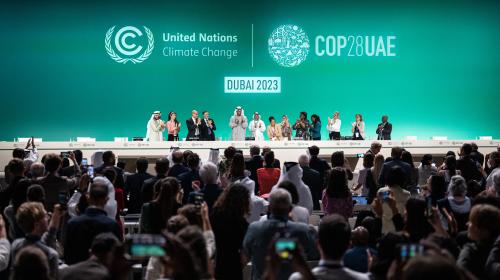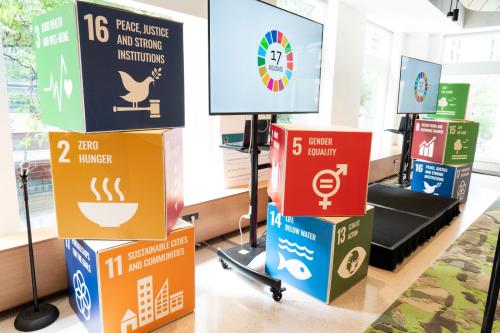The heated policy debate about global warming often seems like a Rorschach test: If you’re an environmentalist, you advocate quick and significant cuts in carbon-dioxide emissions to prevent the worst-case scenario, which includes more-violent storms, changes in the course of the Gulf Stream, melting of the polar ice sheets, and higher sea levels. If you represent an industry group, you argue against taking any action now, because cutting emissions is likely to be expensive, and the benefits are not clear. Unfortunately, neither of those positions is a prudent approach to the problem.
The reason we can’t seem to get beyond the extreme viewpoints is that scientists are uncertain about just how serious the problem of climate change is. It would be far better to forsake simplistic antagonisms, admit our ignorance, and strive for a realistic policy that acknowledges the inherent uncertainties by mandating small, cost-effective steps to reduce global warming.
The basic mechanism behind global warming has been understood for more than 100 years. Energy from the sun, in the form of ultraviolet light, passes through the earth’s atmosphere and is absorbed by objects—trees, buildings, animals, rocks, and so forth-on the ground. The objects later radiate some of the energy back into space, but as infrared rather than ultraviolet light. Some of the gases in the earth’s atmosphere—including carbon dioxide, methane, chlorofluorocarbons, even water vapor-trap that infrared radiation, keeping it near the surface of the earth and thus raising global temperatures. Those gases have become known as “greenhouse gases,” because they keep the earth warmer than it otherwise would be, much the same way that glass keeps a greenhouse warm.
The amount of greenhouse gases in the atmosphere determines how much energy can be trapped, and thus how much heating can occur. Concern about global warming stems from the fact that the concentrations of many greenhouse gases have been increasing sharply. In particular, the use of fossil fuels has raised the level of carbon dioxide in the atmosphere by about 25 per cent since the Industrial Revolution.
Although it is clear that greenhouse gases can trap energy and make the atmosphere warmer, and that the concentration of those gases has been increasing, it is far less clear what those facts mean for global temperatures. Climatologists do not know how much heating will be produced by a given increase in greenhouse gases, or exactly how long after the increase the earth’s temperature will rise.
One issue that we don’t understand is the effect of an increase in global temperatures on cloud formation. Higher temperatures create greater evaporation: That might increase cloud cover. But, since clouds tend to reflect ultraviolet light back to the sun, an increase in cloud cover could reduce global warming. We don’t know whether the net result would be higher or lower temperatures.
Another problem is determining how fast a warmer atmosphere could raise the temperature of the enormous volume of seawater on earth. Air temperatures would rise more slowly if the oceans took decades to warm up. The speed at which the oceans would adjust is hard to predict, however, because it depends on many complicated interactions, such as the mixing of different layers of seawater, that we do not completely understand.
Such uncertainties have actually increased over time, as scientists have looked more carefully at the physical processes involved. A lot of recent research, for example, has focused on something that scientists had previously overlooked: the role of fine aerosol particles that are released into the atmosphere as a byproduct of combustion. Like clouds, those particles reflect part of the incoming solar radiation and thus help offset global warming.
In truth, it is impossible to say exactly how much global warming will occur. Current research suggests that the concentration of greenhouse gases is likely to double during the next century, and that average global surface temperatures will probably rise by two degrees centigrade as a result. The same studies also suggest, however, that the temperature could increase by as little as one degree, or by as much as three and a half degrees. Not only that, but there’s a significant chance that the change will actually be outside that range. Given the complexity of the processes involved, it is not likely that scientists will be able to reduce that uncertainty for decades.
Partly because it has proved so difficult to predict the future effect of greenhouse gases on global temperatures, many participants in the debate-scientists, government officials, environmentalists, and business lobbying groups-have been interested in finding out whether past emissions have had much effect. Here, too, certainty is elusive. In spite of the articles in the popular press that report every hot summer as evidence of global warming, it is actually quite hard to prove that global warming has, in fact, begun. Normal variations in global temperatures are very large compared with the changes that might have been caused by emissions of greenhouse gases. It is difficult to tell whether actual increases in temperature are outside the usual range, and thus to tell if the gases have caused any global warming. What’s more, the data do not always agree, in part because over the years, people have measured temperatures with different kinds of instruments, at different locations, and even at different altitudes. It’s important to remember, however, that those problems make it equally difficult to prove that global warming has not begun to occur.
All the uncertainties have tended to polarize the public debate about what-if anything-should be done. The result has been terrible public policy. In 1997, to satisfy environmental groups, the governments of the United States and most other developed countries signed an ambitious international agreement, known as the Kyoto Protocol, to reduce emissions of greenhouse gases substantially below the rates that prevailed in 1990. To satisfy business interests, however, the United States and many other countries have not yet ratified the agreement or put it into effect. The Clinton Administration has not sent it to the Senate for ratification, nor even said when it plans to do so.
A policy that is very strict in principle but completely ineffective in practice is neither prudent nor realistic. An ineffective policy is not prudent, because it is quite clear that human activity is raising global concentrations of carbon dioxide. Although climatologists disagree about how much warming will occur, and when it will happen, virtually no one is suggesting that we can emit as much carbon dioxide as we want into the atmosphere without any adverse consequences. At the same time, a very strict policy is not realistic. We know too little about the damages caused by climate change to conclude that it must be stopped at any cost. To pretend that climate policy doesn’t need to take financial issues into consideration is to guarantee that any international agreement on climate change will be rejected by the U. S. Senate, as well as by lawmakers in many other countries.
Given the uncertainties, prudent and realistic governments should adopt a global-warming policy with four key features. First, the policy should reduce carbon—dioxide emissions in cases where it is cost-effective to do so. Second, the policy should involve some mechanism for compensating companies that suffer economically from new restrictions. Third, because climate change is a global problem, any solution will require both domestic and international consensus. Thus, different governments need to be able to adapt their implementation of the policy to local political conditions. Fourth, the policy must include provisions for a core group of countries to continue to carry it out, even if other countries reject it; local political forces will inevitably make the policy unpopular in certain places, at certain times. Many proposed global—warming policies have been designed to come into effect only after being ratified by a large proportion of the potential participants; that approach is certain to fail.
One policy that meets those requirements is an international system of emissions permits and fees for the use of fossil fuels. In such a system, each participating country would agree to levy a stipulated fee on all use of fossil fuels when the fuel is first produced or imported. However, countries would be allowed to grandfather existing producers into the system, by giving them permits that would exempt some of their output from the fee. One producer could sell permits to another; or environmental groups could buy permits and retire them.
The United States uses a similar arrangement to control sulfur emissions from electric utilities. Before that system was implemented, in 1995, experts estimated that cutting the emissions would be so expensive that a permit allowing a utility to emit a ton of sulfur would sell for $650 to $1,000. However, the system has encouraged utilities to find innovative ways to reduce emissions, and permits now cost about a tenth as much as predicted.
Under a global-warming policy, the initial user’s fee might be $10 per ton of carbon contained in the fossil fuel-amounting to about $6.50 per ton of coal and $1.40 per barrel of crude oil. Participating governments would give businesses within their borders a certain number of permits. If a business needed to use more fuel, and thus emit more carbon dioxide, it would have to buy additional permits. Thus, the system would include a clear incentive to avoid increases in emissions. At the same time, businesses would have an incentive to reduce their emissions, because they could then sell some of their permits.
Many companies have claimed that they are willing to undertake low-cost emissions abatements. Under the permit system, the more effort they put into reducing emissions cheaply, the higher their profits would be when they sold permits.
The policy would be extremely flexible. User fees, fixed by international agreement, would be set low enough to keep the costs of the policy modest, at least until some of the uncertainties about global warming have been resolved. But the fees could be adjusted as needed when better information became available.
Equally important, it would be easy to add countries to the system over time: Those interested in joining would simply have to adopt the policy domestically; no international negotiations would be required. That flexibility is crucial, because it is clear from current negotiations that only a few countries would now agree to implement a global-warming policy. Also, countries could withdraw from the system without debasing the value of the permits in those countries that continued to participate.
Because such a policy would not focus on achieving a specified target at any cost, it would be far more likely to be adopted, and by more countries, than the Kyoto Protocol. And as a decentralized system put into effect by individual countries, it is more politically attractive than one requiring complicated international agreements. All that would have to be negotiated at the international level are the fee and the number of permits that could be given away; everything else-including the number of permits for sale-would be left up to the individual countries.
It is time to move the debate about global warming away from ideological battles over impractical goals and policies. Instead, we need to discuss policies that would include concrete, but cost-effective, steps to reduce carbon-dioxide emissions.



Commentary
Until We Know More About Global Warming, the Best Policy is a Highly Flexible One
July 2, 1999